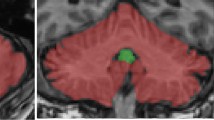Abstract
This paper reviews the relative abilities of magnetic resonance imaging (MRI), positron emission tomography (PET), single photon emission tomography (SPECT), and proton magnetic resonance spectroscopy (MRS) to detect Parkinson’s disease and monitor its progression. Currently, the main role of MRI lies in its ability to discriminate atypical syndromes from Parkinson’s disease; however, new volumetric approaches may soon allow progression of nigral degeneration to be followed. Proton MRS can also detect reduced levels of putamen N-acetyl aspartate (NAA) in many patients with atypical parkinsonian syndromes. PET and SPECT are both sensitive means of detecting the presence of impaired dopamine terminal function in the striatum and following its progression. PET currently has the greater spatial resolution and provides the added advantages that it also allows extra-striatal dopaminergic function to be monitored.
Similar content being viewed by others
Author information
Authors and Affiliations
Rights and permissions
About this article
Cite this article
Brooks, D. Morphological and functional imaging studies on the diagnosis and progression of Parkinson’s disease. J Neurol 247 (Suppl 2), II11–II18 (2000). https://doi.org/10.1007/PL00007755
Issue Date:
DOI: https://doi.org/10.1007/PL00007755




